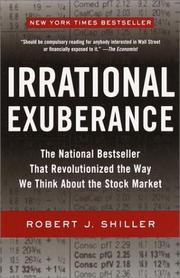| Listing 1 - 7 of 7 |
Sort by
|

ISBN: 0767907183 Year: 2001 Publisher: New York (N.Y.): Broadway books
Abstract | Keywords | Export | Availability | Bookmark
 Loading...
Loading...Choose an application
- Reference Manager
- EndNote
- RefWorks (Direct export to RefWorks)
Dow Jones industrial average --- Risk --- Stock exchanges --- Stocks --- Prices

ISBN: 9780767923637 0767923634 Year: 2005 Publisher: New York: Broadway Books,
Abstract | Keywords | Export | Availability | Bookmark
 Loading...
Loading...Choose an application
- Reference Manager
- EndNote
- RefWorks (Direct export to RefWorks)
Stocks --- Stock exchanges --- Risk. --- Dow Jones industrial average. --- Actions (Titres de société) --- Bourse --- Risque --- Indice Dow Jones des valeurs industrielles --- Prices --- Prix --- Real property --- Risk --- Dow Jones industrial average --- Actions (Titres de société) --- Stocks - United States --- Stock exchanges - United States --- Stocks - Prices - United States --- Real property - Prices - United States
Book
ISBN: 9780691166261 9780691173122 0691166269 0691173125 1400865530 1322519536 9781400865536 Year: 2015 Publisher: Princeton, NJ : Princeton University Press,
Abstract | Keywords | Export | Availability | Bookmark
 Loading...
Loading...Choose an application
- Reference Manager
- EndNote
- RefWorks (Direct export to RefWorks)
In this revised, updated, and expanded edition of his New York Times bestseller, Nobel Prize-winning economist Robert Shiller, who warned of both the tech and housing bubbles, cautions that signs of irrational exuberance among investors have only increased since the 2008-9 financial crisis. With high stock and bond prices and the rising cost of housing, the post-subprime boom may well turn out to be another illustration of Shiller's influential argument that psychologically driven volatility is an inherent characteristic of all asset markets. In other words, Irrational Exuberance is as relevant as ever. Previous editions covered the stock and housing markets-and famously predicted their crashes. This edition expands its coverage to include the bond market, so that the book now addresses all of the major investment markets. It also includes updated data throughout, as well as Shiller's 2013 Nobel Prize lecture, which places the book in broader context. In addition to diagnosing the causes of asset bubbles, Irrational Exuberance recommends urgent policy changes to lessen their likelihood and severity-and suggests ways that individuals can decrease their risk before the next bubble bursts. No one whose future depends on a retirement account, a house, or other investments can afford not to read this book.
Money market. Capital market --- United States --- Stocks --- Stock exchanges --- Real property --- Risk. --- Dow Jones industrial average. --- Prices --- Risk --- Dow Jones industrial average --- Stocks - United States --- Stock exchanges - United States --- Stocks - Prices - United States --- Real property - Prices - United States --- Economics --- Uncertainty --- Probabilities --- Profit --- Risk-return relationships --- Dow Jones averages --- Cadastral surveys --- Catastral surveys --- Freehold --- Limitations (Law) --- Property, Real --- Real estate --- Real estate law --- Realty --- Property --- Rent --- Law and legislation --- United States of America
Book
ISBN: 9782807302037 2807302033 Year: 2016 Publisher: Bruxelles: De Boeck,
Abstract | Keywords | Export | Availability | Bookmark
 Loading...
Loading...Choose an application
- Reference Manager
- EndNote
- RefWorks (Direct export to RefWorks)
Dans cette édition refondue, mise à jour et élargie de son bestseller, l'économiste Robet Shiller, qui mettait en garde contre les bulles à la fois technologiques et immobilières, prévient maintenant que les signes d'une exubérance irrationnelle chez les investisseurs se sont accrus depuis la crise de 2008-2009. Avec les cours élevés des actions et des obligations aux États-Unis et la hausse des prix de l'immobilier dans plusieurs pays, l'essor d'après la crise des subprimes peut parfaitement conduire à une nouvelle illustration de l'argument crucial de Shiller selon lequel la volatilité générée par la psychologie des acteurs est une caractéristique inhérente à tous les marchés d'actifs. En d'autres termes, l'exubérance irrationnelle est plus pertinente que jamais. L'ouvrage explique tous les facteurs qui font monter ou chuter les marchés. Il montre comment l'euphorie des investisseurs peut conduire les prix des actifs à des hauteurs aussi vertigineuses qu'intenables et comment, à d'autres moments, le découragement de ces mêmes investisseurs peut faire baisser ces prix à un niveau très faible. Outre le diagnostic des causes des bulles des actifs, cet ouvrage recommande des changements de politique urgents pour atténuer leur probabilité de survenance et leur ampleur et suggère les moyens pour les individus de réduire les risques qu'ils prennent avant que de nouvelles bulles apparaissent. Aucune personne dont l'avenir dépend de ses placements pour sa retraite, son logement ou tout autre investissement, ne peut se permettre de ne pas lire cet ouvrage !
Stocks --- Stock exchanges --- Real property --- Risk --- Dow Jones industrial average --- Prices --- Capital market --- Speculation --- Marché financier --- Spéculation --- Economic theory --- Economics --- Economie (Science) --- Economie (Wetenschap) --- Economische wetenschap --- Finance --- Finances --- Financiën --- Macro-economie --- Macroeconomics --- Macroéconomie --- Political economy --- Politieke economie --- Sciences économiques --- Marché financier --- Spéculation --- Stocks - United States --- Stock exchanges - United States --- Stocks - Prices - United States --- Real property - Prices - United States

ISBN: 0691050627 0691089159 9780691089157 9780691050621 Year: 2000 Publisher: Princeton: Princeton university press,
Abstract | Keywords | Export | Availability | Bookmark
 Loading...
Loading...Choose an application
- Reference Manager
- EndNote
- RefWorks (Direct export to RefWorks)
Money market. Capital market --- United States --- Stocks --- Stock exchanges --- Risk. --- Dow Jones industrial average. --- Actions (Titres de société) --- Bourse --- Risque --- Indice Dow Jones des valeurs industrielles --- Prices --- Prix --- Risk --- Dow Jones industrial average --- 336.76 --- -Stocks --- -#SBIB:33H13 --- #SBIB:35H435 --- #ECO:02.04:financiële sector geldmarkt kapitaalmarkt beleggingen beurs --- marche des capitaux --- investissements --- information --- psychologie --- US / United States of America - USA - Verenigde Staten - Etats Unis --- 333.613 --- 333.645 --- -Stock exchanges --- -Risk --- 332.632220973 --- Common shares --- Common stocks --- Equities --- Equity capital --- Equity financing --- Shares of stock --- Stock issues --- Stock offerings --- Stock trading --- Trading, Stock --- Securities --- Bonds --- Corporations --- Going public (Securities) --- Stock repurchasing --- Stockholders --- Bulls and bears --- Commercial corners --- Corners, Commercial --- Equity markets --- Exchanges, Securities --- Exchanges, Stock --- Securities exchanges --- Stock-exchange --- Stock markets --- Capital market --- Efficient market theory --- Speculation --- Dow Jones averages --- Economics --- Uncertainty --- Probabilities --- Profit --- Risk-return relationships --- Beurswezen. Geldmarkt. Valutamarkt. Binnenlandse geldmarkt. Valutamarkt --- -Economische politiek --- Beleidssectoren: economisch en werkgelegenheidsbeleid --- kapitaalmarkt --- investeringen --- informatie --- Activiteiten van de nationale en internationale markten. Beursnoteringen van aandelen en obligaties. --- Speculatie op de beurs. --- -Dow Jones industrial average. --- -336.76 --- 336.76 Beurswezen. Geldmarkt. Valutamarkt. Binnenlandse geldmarkt. Valutamarkt --- Actions (Titres de société) --- #SBIB:33H13 --- Economische politiek --- Activiteiten van de nationale en internationale markten. Beursnoteringen van aandelen en obligaties --- Speculatie op de beurs --- Stocks - United States --- Stock exchanges - United States --- Stocks - Prices - United States --- United States of America
Book
Year: 2017 Publisher: Princeton, [New Jersey] ; Oxford, [England] : Princeton University Press,
Abstract | Keywords | Export | Availability | Bookmark
 Loading...
Loading...Choose an application
- Reference Manager
- EndNote
- RefWorks (Direct export to RefWorks)
The scientific study of complex systems has transformed a wide range of disciplines in recent years, enabling researchers in both the natural and social sciences to model and predict phenomena as diverse as earthquakes, global warming, demographic patterns, financial crises, and the failure of materials. In this book, Didier Sornette boldly applies his varied experience in these areas to propose a simple, powerful, and general theory of how, why, and when stock markets crash. Most attempts to explain market failures seek to pinpoint triggering mechanisms that occur hours, days, or weeks before the collapse. Sornette proposes a radically different view: the underlying cause can be sought months and even years before the abrupt, catastrophic event in the build-up of cooperative speculation, which often translates into an accelerating rise of the market price, otherwise known as a "bubble." Anchoring his sophisticated, step-by-step analysis in leading-edge physical and statistical modeling techniques, he unearths remarkable insights and some predictions--among them, that the "end of the growth era" will occur around 2050. Sornette probes major historical precedents, from the decades-long "tulip mania" in the Netherlands that wilted suddenly in 1637 to the South Sea Bubble that ended with the first huge market crash in England in 1720, to the Great Crash of October 1929 and Black Monday in 1987, to cite just a few. He concludes that most explanations other than cooperative self-organization fail to account for the subtle bubbles by which the markets lay the groundwork for catastrophe. Any investor or investment professional who seeks a genuine understanding of looming financial disasters should read this book. Physicists, geologists, biologists, economists, and others will welcome Why Stock Markets Crash as a highly original "scientific tale," as Sornette aptly puts it, of the exciting and sometimes fearsome--but no longer quite so unfathomable--world of stock markets.
Stocks --- Financial crises --- Prices --- History. --- United States. --- Asia. --- Black Monday. --- Dow Jones Industrial Average. --- Hong Kong. --- Latin America. --- Louis Bachelier. --- Nasdaq index. --- Nasdaq. --- Nikkei. --- Russia. --- South Sea bubble. --- anti-imitation. --- antibubble. --- arbitrage opportunities. --- bubble. --- collapse. --- complex systems. --- computational methods. --- cooperative behavior. --- cooperative speculation. --- crash hazard. --- currency crash. --- derivatives. --- discrete scale invariance. --- drawdown. --- efficient market. --- emergent markets. --- extreme events. --- financial crashes. --- finite-time singularity. --- forward prediction. --- fractals. --- free lunch. --- gold. --- hazard rate. --- hedging. --- herding. --- imitation. --- insurance portfolio. --- log-periodicity. --- market failure. --- natural scientists. --- outlier. --- population dynamics. --- positive feedback. --- power law. --- prediction. --- price-driven model. --- random walk. --- rational agent. --- renormalization group. --- returns. --- risk-driven model. --- risk. --- self-organization. --- self-similarity. --- social network. --- social scientists. --- speculative bubble. --- stock market crash. --- stock market indices. --- stock market prices. --- stock market. --- superhumans. --- sustainability. --- tronics boom. --- tulip mania. --- world economy.

ISBN: 0691123357 9780691123356 Year: 2005 Publisher: Princeton, N.J. Princeton University Press
Abstract | Keywords | Export | Availability | Bookmark
 Loading...
Loading...Choose an application
- Reference Manager
- EndNote
- RefWorks (Direct export to RefWorks)
Money market. Capital market --- United States --- US / United States of America - USA - Verenigde Staten - Etats Unis --- 333.613 --- Verenigde Staten van Amerika --- 336.76 --- 333.645 --- Stocks --- -Stock exchanges --- -Stocks --- -Real property --- -Risk --- Dow Jones industrial average --- 332.632220973 --- Dow Jones averages --- Economics --- Uncertainty --- Probabilities --- Profit --- Risk-return relationships --- Cadastral surveys --- Catastral surveys --- Freehold --- Limitations (Law) --- Property, Real --- Real estate --- Real estate law --- Real property --- Realty --- Property --- Rent --- Common shares --- Common stocks --- Equities --- Equity capital --- Equity financing --- Shares of stock --- Stock issues --- Stock offerings --- Stock trading --- Trading, Stock --- Securities --- Bonds --- Corporations --- Going public (Securities) --- Stock repurchasing --- Stockholders --- Bulls and bears --- Commercial corners --- Corners, Commercial --- Equity markets --- Exchanges, Securities --- Exchanges, Stock --- Securities exchanges --- Stock-exchange --- Stock markets --- Capital market --- Efficient market theory --- Speculation --- Activiteiten van de nationale en internationale markten. Beursnoteringen van aandelen en obligaties. --- Geldmarkt. Kapitaalmarkt --- Speculatie op de beurs. --- Prices --- -Prices --- -Law and legislation --- -US / United States of America - USA - Verenigde Staten - Etats Unis --- Risk --- Stock exchanges --- Activiteiten van de nationale en internationale markten. Beursnoteringen van aandelen en obligaties --- Speculatie op de beurs --- Law and legislation --- United States of America
| Listing 1 - 7 of 7 |
Sort by
|

 Search
Search Feedback
Feedback About UniCat
About UniCat  Help
Help News
News